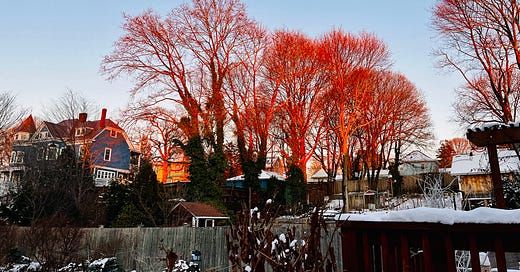Though February is the coldest month on the calendar, January feels the starkest. After the headiness of Christmas and its attendant excesses, the world seems to turn toward the new year with a collective resolve that’s tinged with smiling regret. The YMCA fills with strange new faces, all using the gym equipment badly and for long intervals (I am one of these). Runners multiply on sludgy sidewalks. The cheerful red and green palate of wool sweaters and scarves becomes decidedly more French minimalist. Blinking lights are stripped from the houses, and the landscape seems to hunker down for a collective shiver. It’s not a month we traditionally associate with comfort or good cheer, though it was actually a time of feasting and celebration for the medieval church, in which several of the twelve days of Christmastide fell, not to mention Epiphany. It is, in any case, the darkest season, in which the northern hemisphere has tilted away from the sun, the light comes to us pounded into very thin gold, and the bare trees flail against a punishing sky.
Yet, for all that, there is a sense of beginning. With the winter solstice behind us, daylight is growing slightly longer every day. And it is light, rather than temperature, to which most plants respond in their seasonal cycles. Though no snowdrops are yet peeking through the frosted earth, and though the ground underfoot is hard as stone, the inevitable warming and lightening towards spring has inexorably begun. On the twelfth day of Christmas, it was traditional in England to go “wassailing:” caroling and dancing through the bare orchards to waken them from sleep. So the Anglo-Saxons understood that the tipping point of wintery slumber was already behind us in early January—that we were heading towards something, rather than away from it. In the Christian mind, that thing is best articulated in the celebration of Easter, the Ascension, and Pentecost, the threefold pinnacles of the liturgical year whose far slopes carry us into Ordinary Time, that green season where we’re encouraged to cultivate our own flourishing. If it connects us with this contemplative cycle, gardening can indeed grow into a spiritual discipline.
Whatever your philosophical bent, January is not without its tasks for the gardener:
1/ Plan, Plan, Plan
With no pruning, planting, or weeding to do, January is prime planning time for the gardener. Ideally, a garden should provide interest and invigoration during every season, even when it’s only being glimpsed through a window. January is therefore an excellent time to look at your garden stripped down to its structural essentials and contemplate necessary adjustments. These days, I find myself introducing more and more junipers and ornamental grasses to our borders. Kept in good order, these plants prevent the garden from dwindling into a swath of blasted dirt during the winter months. Their greens and browns look lovely crowned by snow, and the wind sets them into pleasant motion. But it’s also a time when you can look at a blank border and imagine new possibilities. The seed catalogs will arrive in the mail this month, and it’s best to be ready.
2/ Tend Your Houseplants
I returned from Christmas break this morning to find Felicia, my classroom’s beloved Fiddle Leaf Fig sapling, collapsed in her terra cotta pot. It’s possible that she can be revived with a little water, but it was a good reminder that even hardy houseplants can’t just be left alone for weeks at a time without consequences. As the air turns cold it also turns dry and, since most houseplants originated on jungle floors, the lack of humidity is deadly to them on a long enough timeline. A two-dollar spray mister from Amazon, used about once a week, will suit them very well during this season. Paradoxically, though, they should be watered a little less often in winter, since the lack of sunlight means they’ll be photosynthesizing less and therefore consuming fewer resources. As always, the last thing you want is for your houseplants to sit in sopping wet soil.
3/ Read Up
As you plan, this is also the season to improve your knowledge base. This doesn’t necessarily mean consuming multiple volumes. It can mean reading a book here and there—and there’s also something to be said for forgetting about the garden for a while as you read the novel or learn how to cook souffle. Still, you may want to do some of the gardening reading over the winter that you didn’t get to do during the summer. I always favor physical books when it comes to deepening your garden knowledge, but I’m also a big fan of GardenDesign.com, which houses a stunning volume of good articles and even hosts video conferences on specific topics. It’s also a great season to take advantage of any milder days to go on excursions to public green spaces or to trust-owned properties where good gardens are maintained. You’ll usually have the place to yourself and, walking the paths, it’s easy to get some good thinking done and get inspired. Gardens serve people, not the other way around, and we need the bracing freshness of the outdoors in winter as much as we do the lusher and warmer landscapes of summer.




